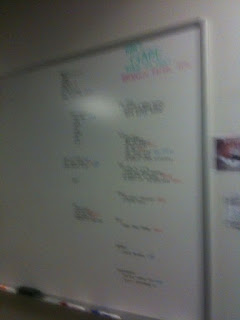 After about three weeks, my big to-do list on the whiteboard (blurred in this photo, because it's seekrit) isn't so useful. Mostly it's because I know which parts of it I'm trying to ignore every time I glance at it. Humans are really good at ignoring unwanted visual queues.
After about three weeks, my big to-do list on the whiteboard (blurred in this photo, because it's seekrit) isn't so useful. Mostly it's because I know which parts of it I'm trying to ignore every time I glance at it. Humans are really good at ignoring unwanted visual queues.So I rebuild it. I snap a picture of everything, then I erase it all and transcribe it back in a different form that makes sense at the time. Some times you group by application type, other times it's customer groups, other times it's products that group things. This lets me organize the constellations, and it also reminds me of the things I've been avoiding. Plus, it lets me cross off things that are in the nice-idea-never-gonna-happen category.
Next, I go through all my scraps of jotted notes (textedit files, reminders emailed to myself, and stickies files) and assign tickets to myself. Anything that stays "jotted" for more than a couple weeks is in danger of neglect ... so a ticket means I think it's important enough that it should get done.
Then, I sweep through and re-prioritize all my tickets to reflect the current state of customer-panic and looming deadlines. And finally I take my current ticket list and make sure that there's a reference to each task on my big whiteboard to-do list.
If you're keeping count, that's actually two lists with a lot of overlap, between the whiteboard and the ticket queue. It seems like duplicated work, but it's necessary for my workflow. You see, when I "wanna" do some new task, I tend to look at the whiteboard to see what jumps out. But when I "hafta" do things, I look at the ticket queue and the top priority gets worked on next.
You always hear productivity people say "make a list" but I don't think I've ever heard one say "make two overlapping lists." Odd.
No comments:
Post a Comment